Author: helloyyy, Mirror
Foreword:
This is an unconventional research report on Babylon, and also a milk article and warning about Bitcoin re-staking. This article was written on the 12th day after the Bitcoin halving, the XXth day of the Bitcoin re-staking track, and the XXXth day of the Bitcoin re-staking bubble burst.
Without keeping you in suspense, let me first say the conclusion. The Bitcoin re-staking track represented by Babylon will blow up a huge bubble in the Bitcoin ecosystem. This Restaking revolution originated from the Bitcoin ecosystem will have an influence no less than that of the inscription.
This article is dedicated to the feelings of many friends who want to take advantage of the Bitcoin re-staking boom like me.
I. Causes of the bubble
1) BTC's transformation from a store of value to an interest-bearing asset
Since the birth of Bitcoin, BTC has been regarded as a digital gold for value storage. It is difficult for BTC holders to obtain excess returns such as Defi, and BTC has become an idle sediment asset on the chain.
According to Deflama data, interest-bearing Bitcoin is currently scattered across 87 chains, 412 protocols, and 574 liquidity pools. Without exception, all interest-bearing Bitcoins have left the original Bitcoin chain, and there are some degree of trust assumptions in the form of encapsulation and bridging of BTC (such as the most widely used WBTC, which requires trust in a single entity, and the BTC of the sidechain/L2, which requires trust in the multi-signature committee, etc.);
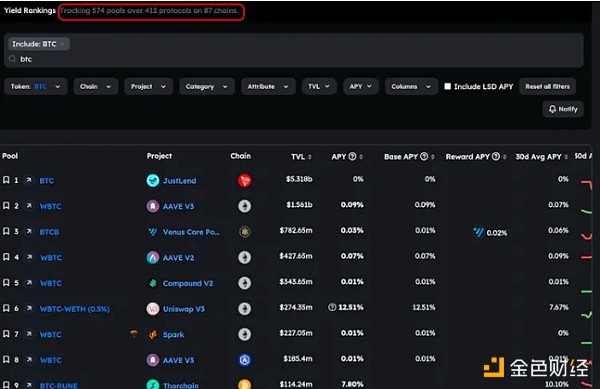
According to data provided by Messari researcher @NikhilChatu, the current scale of interest-bearing BTC exceeds US$10 billion, of which US$4 billion is earning income, with a yield of between 0.01% and 1.25%. Interest-bearing BTC realized through custody solutions all have more or less trust assumptions.
2) The awakening of non-custodial Bitcoin solutions
Centralized custody risks have become an insurmountable mountain on the road to Bitcoin interest generation, and non-custodial Bitcoin staking solutions have become a shortcut to cross the mountain. Non-custodial Bitcoin, also known as self-custodial Bitcoin solutions, in short, means that BTC achieves asset interest and appreciation without leaving the original Bitcoin chain, without encapsulation, without cross-chain, without custody, and without adding any trust assumptions.
Currently, the only protocol that realizes non-custodial Bitcoin on the main network is CoreDAO, and Babylon (another non-custodial Bitcoin staking solution) is in the test network stage and has not yet been launched on the main network.
So far, BTC can achieve asset interest in a trustless and safer way, whether through BTC staking mining or through re-staking to provide security services for PoS sub-chains.
EigenLayer, a leading protocol focusing on Ethereum Restaking scenarios, has a TVL of $15 billion on the chain, accounting for 5% of Ethereum's circulating market value; Bitcoin has a market value of more than $1 trillion, and unlocking 1.5% of its liquidity can leverage $15 billion. The non-custodial Bitcoin Restaking track is currently in a blank, like a baby in a cradle, and Babylon, which is positioned in this track, has its unique advantages.
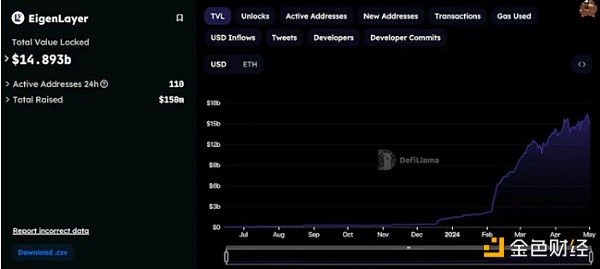
But at the same time, a bubble crisis about Bitcoin re-staking is quietly brewing.
The next chapter will talk about why we embrace bubbles. As for why we think it is a bubble and why the bubble will burst, it will be discussed in the last chapter of the full text.
Second, knowing that the bubble will burst, why embrace it?
1) Narrative drive
The main theme of the narrative of this bull market cycle is the Bitcoin ecosystem. From the narrative of new Bitcoin assets (Ordinals BRC20, Atomicals ARC20, RGB++, Runes, etc.) to the explosion of various Bitcoin second layers (Merlin, Bouncebit, etc.), it has brought users fascinating narratives such as new Bitcoin assets and Bitcoin smart contract scenarios. Babylon and CoreDAO brought the narrative of non-custodial Bitcoin staking/restaking to the leeks, clearly telling the leeks that our technology can be used for staking/restaking without transferring your BTC control on the Bitcoin chain, making Bitcoin an interest-bearing asset. This seed, which symbolizes love and freedom (enjoying the security and decentralization/trustlessness of the Bitcoin mainnet), has begun to take root in the hearts of the leeks. The narrative of non-custodial Bitcoin is attractive enough, and it is just waiting for a round of spring rain from the rotation of Bitcoin sectors.
CoreDAO has launched non-custodial Bitcoin staking on the mainnet. Here, I will briefly talk about the implementation principle of non-custodial Bitcoin staking through CoreDAO.
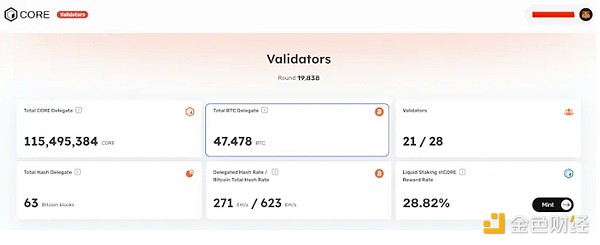
Non-custodial BTC is also called self-custody or native staking. BTC is not encapsulated, cross-chain, or adds any trust assumptions. It is only on the Bitcoin chain and relies only on the Bitcoin native scripting language.
The core of the non-custodial BTC staking technology is the application of CLTV time locks.
CLVT: OP_CHECKLOCKTIMEVERIFY (CLTV) time lock is a specific opcode in the Bitcoin scripting language that allows conditions to be created based on time or block height until these conditions are met, and Bitcoin cannot be spent from the transaction output.
The specific implementation process is as follows:
The user sends Bitcoin from one address to another address with a time lock (the receiving address is derived from the user's main wallet private key, and the user has control over the address assets). In addition, the transaction needs to include an op_return output, which contains the following 2 parts of information:
1) The address of the CoreDAO chain validator to which the staker wishes to delegate Bitcoin;
2) The address to which the staker wishes to receive CORE token rewards.
After the time lock expires, the user can spend the UTXO using the corresponding redemption script.
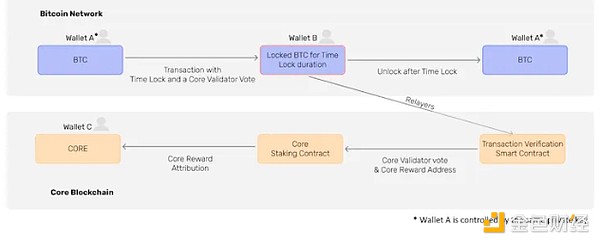
At this point, BTC native staking is complete. Users cannot spend Bitcoin before the staking period ends. BTC participates in the consensus of the CoreDAO chain through native staking, providing BTC with an opportunity to earn CORE token rewards in exchange for their contribution to the CoreDAO chain consensus.
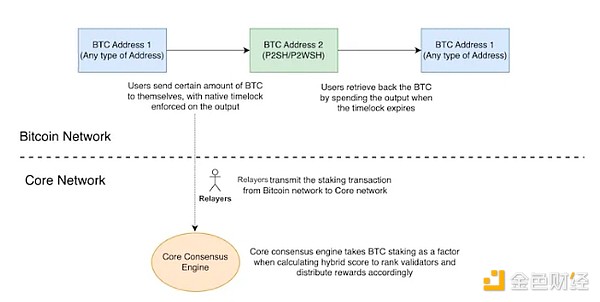
The implementation mechanism of Babylon's non-custodial BTC is similar to CoreDAO, and the time lock technology is used to set the spending conditions and Slash conditions for BTC. When users implement the "BTC staking" operation on the Bitcoin mainnet, they actually entrust BTC to Babylon's validator node through the time lock technology to provide consensus for the Babylon chain to obtain consensus rewards. If the validator node acts maliciously, since the slash condition of BTC UTXO has been set before, the non-custodial BTC will be sent to a destruction address.
Babylon's "upgrade" function based on CoreDAO is to propose the concept of Bitcoin re-staking. If non-custodial BTC staking can provide services for Babylon's consensus, then this consensus service can also be extended to any PoS chain that integrates Babylon. In short, the act of entrusting BTC to other PoS chains to provide consensus services and obtain consensus rewards through Babylon as an intermediary is called Babylon's Bitcoin re-staking.
Babylon acts as an intermediary between the Bitcoin network and other PoS chains that integrate Babylon, aggregating important transactions (such as staking, unstaking, double spending, review transactions, etc.) that occur on the PoS chain and publishing them to the Bitcoin network through timestamps. Based on the timestamp service, the time for PoS chain consensus asset unstaking will be significantly shortened (from weeks to hours).
According to the information provided by Messari, Babylon has currently cooperated with 45+ projects, including many popular Cosmos ecological chains such as Cosmos Hub, Injective, Sei; AI & DePin chain; Bitcoin L2 chain, etc. That is to say, through the Bitcoin re-staking service provided by Babylon, users' BTC assets on the Bitcoin chain can work several jobs at the same time (provide consensus services for multiple PoS chains) and receive multiple salaries (consensus incentives from different PoS chains) without leaving the original Bitcoin chain, being non-custodial and trustless.
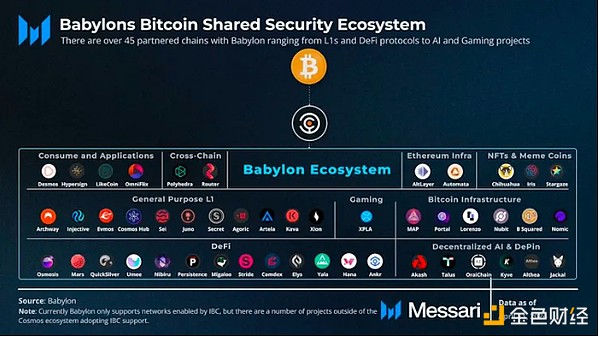
2) Demand-driven
The Bitcoin ecosystem has always been the continuous narrative of this bull market cycle. From the battle for new assets in the Bitcoin ecosystem to the battle of hundreds of chains in Bitcoin L2, it is difficult to say that it is driven by actual demand. It is more driven by the hype demand of hot spots and concepts.
The non-custodial Bitcoin re-staking track represented by Babylon is closer to a narrative driven by actual demand. BTC has always been considered as a value reserve in the crypto world, but there is no asset interest-bearing scheme widely recognized by the market. The reason can be attributed to the fact that there is currently no sufficiently decentralized, trustless, and secure solution to achieve BTC defi income.
When the more decentralized and secure Bitcoin self-custody solution provided by Babylon is verified by the market to be stable and feasible, and can obtain stable Bitcoin re-staking income, we can make an optimistic assumption that we have reason to believe that large investors are willing to use the idle BTC in the cold wallet to "work and make money", and the behavior of large investors can also drive the FOMO of small investors.
Institutional Driven
After talking about narrative driven and demand driven, let's take a look at Babylon's financing situation.
Babylon announced in December 2023 that it had completed a round of financing of $18 million led by Polychain Capital and Hack VC, with participation from Framework Ventures, ABCDE Capital, IOSG Ventures, Polygon Ventures and OKX Ventures; in February 2024, Binance Labs announced the completion of a round of financing for Babylon, the specific amount of which is unknown.
From the financing of Binance Labs in the Bitcoin re-staking track, it can be seen that Babylon is a very important part of Binance's entry into the Bitcoin ecosystem. Binance Labs has successively announced financing for projects such as Babylon, StakeStone, and Bouncebit. Binance undoubtedly sees the huge potential of this specific track of the Bitcoin ecosystem.
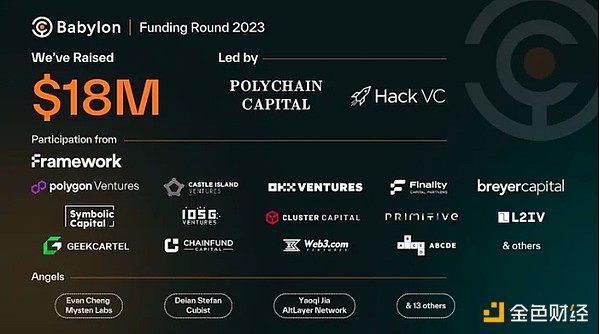
Third, without exception, the bubble will eventually burst
The Bitcoin re-staking track represented by Babylon is leading the direction of the Bitcoin ecological narrative. Driven by multiple factors, the bubble will be blown bigger and bigger, and the liquidity of a huge amount of Bitcoin deposited assets will be unlocked. But the bubble will eventually burst when the market sentiment is at its highest, and the big players will be full of money, and the leeks will wake up from their dreams.
1) Risk superposition under the nesting doll mechanism
As mentioned earlier, Bitcoin re-staking through Babylon can provide consensus services for multiple PoS chains and obtain multiple consensus rewards. But risk and return are proportional. Every additional return will increase the risk of slashing. Under the multiple nested slashing mechanism, the risk will be infinitely magnified.
2) From demand-driven to demand-sluggish, negative economic flywheel is generated
The demand for Bitcoin re-staking comes from the fact that BTC holders can obtain considerable restaking returns in a safer way. In the down cycle, the price of the consumer chain consensus incentive token falls, resulting in a sharp drop in restaking returns. At this time, a trade-off point will appear.
If the potential slashing risk is greater than the potential restaking returns, there will be a BTC unstaking trend, the trust crisis will spread, the big players will flee, and the retail investors will follow. Demand tends to be sluggish, and a negative economic flywheel will be generated.
Postscript
Finally, from an emotional perspective, assuming that Babylon's life cycle also follows Buffett's wise saying: "I am greedy when others are fearful, and I am fearful when others are greedy." At least now, it is far from the time when others are greedy.
The re-staking of Bitcoin will create an unprecedented Bitcoin ecosystem bubble, but before the bubble bursts, please welcome and embrace it.
 JinseFinance
JinseFinance
 JinseFinance
JinseFinance JinseFinance
JinseFinance JinseFinance
JinseFinance JinseFinance
JinseFinance WenJun
WenJun JinseFinance
JinseFinance JinseFinance
JinseFinance JinseFinance
JinseFinance Coinlive
Coinlive  Tristan
Tristan